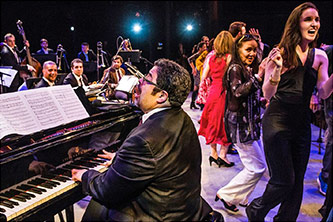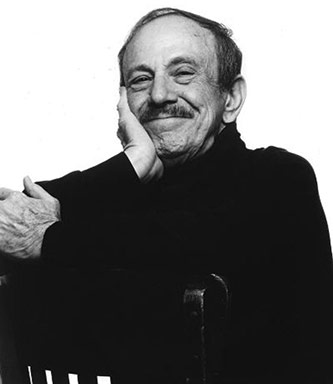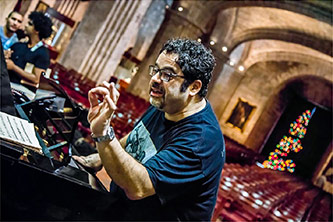American Music Review
Vol. XLVI, Issue 1, Fall 2016
By Arturo O’Farrill, Brooklyn College, CUNY
On 14 December 2014, the night before the historic announcement by Presidents Barack Obama and Raul Castro of renewed US/Cuban relations, the Afro Latin Jazz Orchestra (ALJO) was performing at the official Havana residence of the American Interest’s Section Chief (now Ambassador), Jeff De Laurentis. With members of my non-profit, the Afro Latin Jazz Alliance, the twenty-one musicians who made up the ALJO, and a bevy of special invited guests and producers, we numbered about sixty. The ALJO had traveled to Cuba to perform at the International Havana Plaza Jazz Festival, along with special American guest performers and composers alto saxophonist Rudresh Mahanthappa, pianist/composer Michele Rosewoman, my sons Zachary and Adam, and Cuban musical legends Juan “Cotó” De La Cruz Antomarchi, Bobby Carcasses, Alexis Bosch, Michel Herrera, and Yasek Manzano.
In addition to our performance at the Festival, which included the Orchestra’s debut with Malpaso, Cuba’s premier independent modern dance company, we had come to record what would become a double CD titled Cuba: The Conversation Continues. This recording was based on an imagined conversation between Dizzy Gillespie and Chano Pozo in the 1940s when they first began to recognize the common roots of American jazz and Afro-Cuban music. In fact there is a famous quote attributed to Dizzy in which he claimed “Chano doesn’t speak English and I don’t speak Spanish but we both speak African.” I was curious how the music we call jazz today would sound if the division between jazz and Latin music had been erased as Dizzy envisioned. With this in mind we asked several prominent American and Cuban composers to imagine what the results of that conversation would sound like were the two genres not separated by political revolution and sixty years of a failed embargo.
Back to the party at Laurentis’s residency. On this particular evening we were given a private audience with the soon-to-be Ambassador who seemed preoccupied and nervous. Months later we learned that he knew about the next morning’s historic announcement but was unable to share this top secret information with any of his staff or even with his wife. He not only knew that the two Presidents were going to announce the normalization of relations between the United States and Cuba, but that lan Gross, an American in Cuban prison on espionage charges, was about to be released.
The group I had brought with me to Cuba included high level business men and woman, investors, and industry leaders. At the meeting they asked Mr. De Laurentis about the progress of Cuban and American relations and about what worried him. One specific question asked was, “What keeps you up at night?” With a mysterious look on his face he answered, “Making sure Mr. Gross gets home.” We should have surmised at that point that real progress was about to take place.
The Sephardic Synagogue in the Vedado neighborhood in Havana was where Malpaso rehearsed. The next day we amassed our combined forces of dancers, musicians, producers, staff and onlookers to begin work for our performance of 24 Hours, a modern ballet choreographed by Malpaso’s founder and artistic director Osnel Delgado, and set to my own musical compositions and performances. We were in the midst of this process when the word broke out that a historic moment was about to take place; we went downstairs and gathered around a TV with community members and watched Presidents Castro and Obama announce that there was to be an immediate normalization of relations between Cuba and the United States.
Watching the faces of Cubans and Americans alike, I was struck by the calm detachment and seriousness with which the news was met. It was almost anticlimactic. I myself snuck off to a corner and quietly wept because my father never lived to see this day and because my people would perhaps have a chance to escape the poverty and isolation they had experienced for decades. I had been quietly going to Cuba since 2002, leading people-to-people exchange groups, appearing at jazz festivals, and doing everything in my power to work for the day when this would occur and to insure that culture was the conduit for change and not commercial exploitation. To see the realization of what seemed like an impossible dream was completely beyond my comprehension.
My father, Chico O’Farrill, was born in Cuba in 1922. He left the Island as a young man in his twenties to make his fortune as a jazz musician and never returned to live among his people on any permanent basis. During the revolution he visited frequently but after the declaration by Fidel Castro of communism he felt betrayed and never went back. Settling in New York in the 1940s, he went on to become one of the premiere jazz arrangers and composers of his generation. His work with the likes of Machito, Benny Goodman, Charlie Parker, Dizzy Gillespie, Art Farmer, Thad Jones, Count Basie, Miguelito Valdes, Tito Puente, Celia Cruz, and many more, was foundational for the art of modern, multilingual music that came to be called “Latin Jazz.”
Towards the end of his life my father was invited to perform in Havana but declined because of pressure from the Miami Cuban American community, whose mistaken anti-engagement policies created heartaches and tragedy for generations of families torn apart by ideological rifts and anger at oppressive regimes on both sides of the Florida straits. In the last year of his life he relented and agreed to return, but his failing health prevented the trip. It was difficult for me to watch my father’s heart break because he never saw his ancestral land again.
In 2002 my dear friend and Havana Jazz Festival president Chucho Valdés invited me to perform in a solo piano recital tribute to Emiliano Salvador, the great Cuban pianist. I was thrilled but almost didn’t go. Two weeks before the departure, the vagaries of the Cuban communication world had prevented me from confirming either a performance venue or accommodations. Legally Americans could not accept payment for performing in Cuba. When I e-mailed the festival and relayed my fears, they wrote back that it was important I not cancel as they had a “special surprise” in store for me.
When I landed I was overcome with emotion. It felt as if the ground beneath me had reached up into my soul. After clearing customs and immigration I was met by several gentlemen in suits who I assumed were either Cuban police or CIA. I feared the worst—it was very difficult to get a cultural license back in those days and I was concerned that I might have overlooked some legality that would result in my interrogation and arrest. But instead of pulling up to a detention center, we came upon a beautiful stone structure with huge wooden doors and highly polished brass plates which read “El Palacio O’Farrill.” As we turned the corner we saw a line of people in uniforms waiting outside: clerks, waiters, house staff and executives. The door to our car was opened and an elegant woman reached in shook my hand and said, “welcome home Señor O’Farrill.” There were tears in everyone’s eyes, including my own. I was welcomed into a beautiful hotel with a massive interior courtyard and ornate stonework, all polished wood and brass. It was explained to me that this was one of the properties my ancestors had built and that Old Havana was filled with structures built by the O’Farrills, who were apparently very successful business people. I learned that one of my relatives had been Don Ricardo O’Farrill, one of the original mayors of Havana and the founder of the first musical conservatory in Cuba.
That trip ignited a lifelong project to continue the conversation that Chico, Dizzy, and Chano had begun more than half a century ago and that the United States and Cuba were now resuming. The ranks of important musicians who live in both countries today that are at the vanguard of redefining not just jazz but contemporary music is quite impressive. In the New York jazz community alone there is tremendous respect for Cuban musicians Yosvanny Terry, Elio Villafranca, and Pedrito Martinez, and for composers Tania León, Leo Brouwer, and many more. The ways in which the United States and Cuba have influenced one another is profound and reads more like a love story. Baseball, Hemingway, modern dance, ballet, cigars, salsa, and tasty cuisine are conduits for a people who have long loved and admired each other’s journeys.
Scholars and musicians have long recognized that Cuba has been a crossroads where African musical practice and European traditions have collided for centuries, creating the template for rhythms that are at the heart of many contemporary forms of music, ranging from Rock & Roll to Hip Hop, from Salsa to Reggaeton, and numerous genres in between. While Cuba has been one of the foremost crucibles for such mixing, this musical richness spread throughout the New World. Wherever Africans were allowed to keep their musical expressions and wherever European musical traditions were practiced, jazz-like musical practices evolved, a point to which I will return shortly.
My father was a prototype of the evolved musician of today. Classically trained, culturally influenced by Africa, and fiercely in love with the American interpretation of these forces, he was a perfect middleman. Positioned to mine European tradition, the African legacy, and the New World cultural fabric, he was as easily at home writing a symphony for strings as he was writing big band jazz or Rumba-inspired composition. His music flowed from the commingling of all three worlds.
In 2001 my father joined the ancestors and shortly after my own work with Cuba began. The greater part of my journey, however, was in seeing a larger definition for this music than even the one Dizzy and Chano hinted at. Early on in my work I realized that the reintroduction of jazz to its Afro-Cuban ancestry was sufficient for the early 1940’s, but today the paradigm needed expanding—anywhere the African and European musical worlds intersected offered fertile ground for jazz and jazz-like art forms to emerge. Clearly a more global vision stretching beyond Havana and Nueva York was necessary.
In 2002 at the invitation of Wynton Marsalis and Jazz at Lincoln Center I created an ensemble called The Afro Latin Jazz Orchestra. From the start we were defined by a larger musical geography than the Caribbean island to our south. We began to experiment with Afro-Peruvian and Afro-Andean jazz, with rhythms like the Festejo and the Lando and with Colombian rhythms like the Porro, the Currulao, and Cumbia. Throughout the Americas we saw strains of the current that only the North Americans would have the hubris to claim they invented. In point of fact, the elements of blues, improvisatory practice, call and response, rhythmic swing, and all of the musical characteristics that musicologists define as American jazz, have long existed throughout the Americas.
This revelation was exciting to me as a musician and scholar but most of all as a composer. In 1948 Chico O’Farrill wrote the iconic Afro Cuban Jazz Suite for Charlie Parker, Flip Philips, Buddy Rich, and Machito with his Afro Cuban Jazz Orchestra. In its time it was a revolutionary, multi-movement suite, featuring state-of-theart bebop jazz language, hyper-virtuosic soloing, and hot Afro-Cuban jazz rhythms. The piece has been universally hailed as one of the staples of contemporary jazz and is taught in conservatories throughout the world. It was a critical success as well, garnering praise from critics, scholars, ethnomusicologists and historians alike.
For me, the desire to compose a piece based on the same aesthetic that guided my father’s Afro Cuban Jazz Suite for the sixty-fifth anniversary of the recording and the eightieth anniversary of Harlem’s legendary Apollo Theater was not nostalgic. I did not pine for those days nor did I think that replication of these sounds was healthy for the future of jazz. Rather, I wanted to call attention to the spirit of experimentation, inclusion, and restless vision that guided the composition and also spoke to the many worlds through which Chico moved, which gave him a clear command of the techniques necessary to write such a transcendent work.
I tapped saxophone virtuoso Rudresh Mahanthappa, employed modern jazz language of cluster and tonal centered harmony, wrote in the rhythmic language of contemporary Latin idioms from Colombia, Peru, and Pan America/Africa, and composed a multi-movement suite that celebrated the progressive restlessness and vision that infused so much of Chico O’Farrill’s output. Like my father I am a musician caught in the midst of many worlds, a classically trained pianist and composer, an Afro-Latino-centered performer, and a jazz pianist by trade. The resulting Afro Latin Jazz Suite is a direct result of these influences that stretch beyond boundaries, geographies, and genres.
In this spirit I entered the next phase of my career, honing the ALJO over a fifteen-year span that has shaped the music into a modern, Pan American, Pan African, Pan Latino instrumental sound that consciously questions the very nature of what most would consider “Latin Jazz.” My teaching philosophy is also based on the simple precept that the music we call jazz is really Afro Latin based and one in which we’ve barely scratched the surface. Why we limit ourselves to terms like jazz, Latin, classical and otherwise is lost on me and apparently was lost on my father. We see music from the privileged vantage point of being in the midst of many worlds and are ready to propel the music we love into uncharted waters.
To that end the Brooklyn College Conservatory of Music, with the assistance of the H. Wiley Hitchcock Center for Studies in American Music, has given me the privilege of creating a unique Jazz Master’s program. Our Master’s in Global, Contemporary, and Experimental Jazz will deal with the newest strains in this music. We will study, teach, and perform music from across the planet including Indo-Pak, Arabic, and Afro-Latin traditions. We will delve into the Afrocentric worlds of Free and Avant-garde jazz as exposited in the AACM and the Chicago School. And we will explore the nexus of Electro-Acoustic jazz and the exciting horizon of contemporary notated and improvised performance practice. The days when practitioners had to choose a single style or genre and restrict themselves to a solitary musical reality are rapidly disintegrating, as evidenced by the final movement of my Afro Latin Jazz Suite (entitled What Now) that was written to celebrate the melodic, harmonic, and rhythmic contours of Indian-inspired sonic expression filtered through a Mozambique contemporary Afro-Latino rhythmic style.
Several days after Castro and Obama’s historic announcement the ALJO Orchestra, along with assembled guest musicians producers and staff from across the globe, found themselves happily ensconced in Havana’s Abdalla studios. I looked out across the room and thought about the remarkable journey this music has taken. We recorded a historic two-CD set which so far has garnered two Grammy awards (including one for best original composition) and singled itself out for international critical acclaim, much as my father’s Afro Cuban Jazz Suite did nearly seventy years earlier. How? By taking chances, rewriting the rules, and challenging the very norm understood to be jazz, as Dizzy Gillespie and Chano Pozo taught us to do when they first engaged in their “Conversation.”
The Conversation continues indeed!









